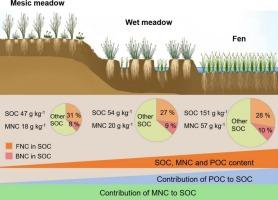涝渍增加了高寒草甸土壤微生物坏死体碳和颗粒有机碳
IF 5.7
1区 农林科学
Q1 GEOSCIENCES, MULTIDISCIPLINARY
引用次数: 0
摘要
气候变暖和人类活动引起的水文变化对草地土壤有机碳(SOC)积累有显著影响。微生物坏死块碳(MNC)和颗粒有机碳(POC)在形成稳定和不稳定的有机碳储层中起着关键作用。然而,在高寒草原-湿地连续体中,MNC和POC的积累、对有机碳的贡献以及控制这些过程的机制尚不清楚。沼地对表层土壤有机碳的固存效率分别比中草甸和湿草甸高320%和280%。涝渍增加了表层和底土中MNC、真菌坏死体碳(FNC)和细菌坏死体碳(BNC)的含量,而MNC在有机碳中所占的比例在高寒草地-湿地连续体中保持稳定,平均为32%。此外,涝渍也增加了POC的含量,厌氧沼泽中POC在有机碳中所占的比例高于mesic草甸。较低的FNC/BNC比例和较高的POC比例表明淹水泥塘有机碳稳定性降低。相关分析和结构方程模型表明,微生物生物量和pH值是表层土壤MNC的关键决定因素,而微生物生物量、铁和铝氧化物主要决定底土MNC。涝渍增加了土壤中总MNC和POC含量。虽然跨国公司对SOC的贡献保持稳定,但POC对SOC的贡献显著增加。因此,沼泽区有机碳稳定性下降,预示着高寒草甸湿地面积减少可能带来的碳流失风险。本文章由计算机程序翻译,如有差异,请以英文原文为准。

Waterlogging increases microbial necromass carbon and particulate organic carbon in alpine meadow soils
Hydrological changes induced by climate warming and human activities significantly impact soil organic carbon (SOC) accumulation in grasslands. Microbial necromass carbon (MNC) and particulate organic carbon (POC) plays a pivotal role in forming stable and labile SOC reservoirs. However, the accumulation of MNC and POC, their contribution to SOC, and the mechanisms governing these processes along the alpine grassland-wetland continuum remain unclear. We investigated the effects of a hydrological gradient on MNC and POC accumulation and their contributions to SOC, as well as the underlying mechanisms in topsoil and subsoils on the Tibetan Plateau. Fens had 320% and 280% higher SOC sequestration efficiency in the topsoil than mesic and wet meadows, respectively. Waterlogging increased the total MNC, fungal necromass carbon (FNC), and bacterial necromass carbon (BNC) content in both topsoil and subsoil, while the MNC proportion in SOC remained stable at an average of 32% along the alpine grassland-wetland continuum. Additionally, waterlogging also increased POC content, with a higher proportion of POC in SOC observed in anaerobic fens compared to mesic meadows. Lower FNC/BNC ratios and a higher POC proportion in SOC indicate reduced SOC stability in waterlogged fens. Correlation analysis and structural equation modelling showed that microbial biomass and pH were key determinants of MNC in the topsoil, while microbial biomass, iron and aluminum oxides primarily determined MNC in the subsoil. We conclude that waterlogging increases total MNC and POC content in soil. While the MNC contribution to SOC remains stable, the POC contribution to SOC increases significantly. Thus, SOC in fens exhibits reduced stability, forewarning of potential C loss risks associated with the decline of wetland areas in alpine meadows.
求助全文
通过发布文献求助,成功后即可免费获取论文全文。
去求助
来源期刊

Catena
环境科学-地球科学综合
CiteScore
10.50
自引率
9.70%
发文量
816
审稿时长
54 days
期刊介绍:
Catena publishes papers describing original field and laboratory investigations and reviews on geoecology and landscape evolution with emphasis on interdisciplinary aspects of soil science, hydrology and geomorphology. It aims to disseminate new knowledge and foster better understanding of the physical environment, of evolutionary sequences that have resulted in past and current landscapes, and of the natural processes that are likely to determine the fate of our terrestrial environment.
Papers within any one of the above topics are welcome provided they are of sufficiently wide interest and relevance.
 求助内容:
求助内容: 应助结果提醒方式:
应助结果提醒方式:


